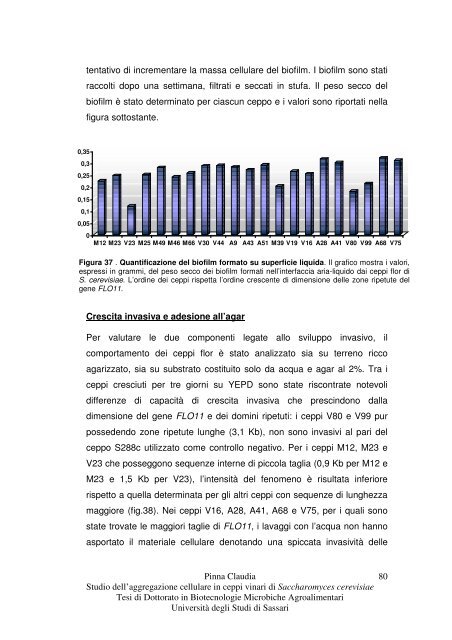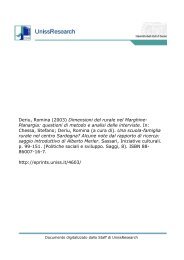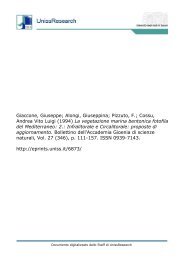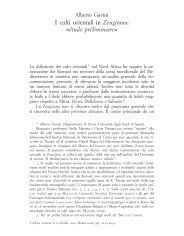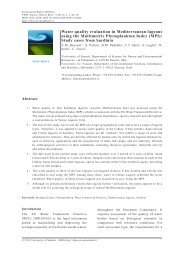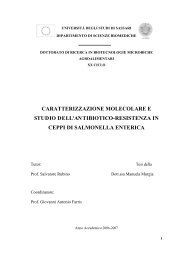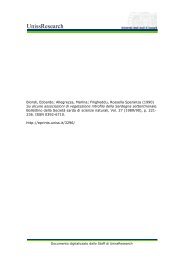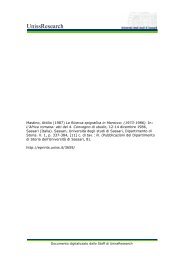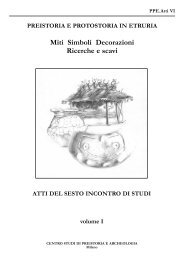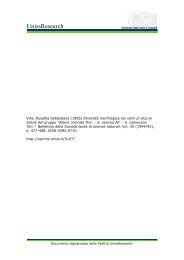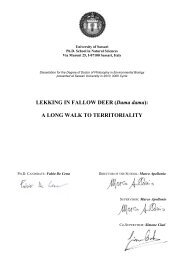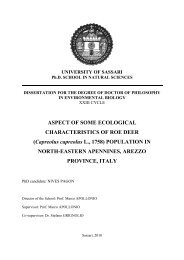Studio dell'aggregazione cellulare in ceppi vinari di Saccharomyces ...
Studio dell'aggregazione cellulare in ceppi vinari di Saccharomyces ...
Studio dell'aggregazione cellulare in ceppi vinari di Saccharomyces ...
Create successful ePaper yourself
Turn your PDF publications into a flip-book with our unique Google optimized e-Paper software.
0,35<br />
0,3<br />
0,25<br />
0,2<br />
0,15<br />
0,1<br />
0,05<br />
tentativo <strong>di</strong> <strong>in</strong>crementare la massa <strong>cellulare</strong> del biofilm. I biofilm sono stati<br />
raccolti dopo una settimana, filtrati e seccati <strong>in</strong> stufa. Il peso secco del<br />
biofilm è stato determ<strong>in</strong>ato per ciascun ceppo e i valori sono riportati nella<br />
figura sottostante.<br />
0<br />
M12 M23 V23 M25 M49 M46 M66 V30 V44 A9 A43 A51 M39 V19 V16 A28 A41 V80 V99 A68 V75<br />
Figura 37 . Quantificazione del biofilm formato su superficie liquida. Il grafico mostra i valori,<br />
espressi <strong>in</strong> grammi, del peso secco dei biofilm formati nell’<strong>in</strong>terfaccia aria-liquido dai <strong>ceppi</strong> flor <strong>di</strong><br />
S. cerevisiae. L’ord<strong>in</strong>e dei <strong>ceppi</strong> rispetta l’ord<strong>in</strong>e crescente <strong>di</strong> <strong>di</strong>mensione delle zone ripetute del<br />
gene FLO11.<br />
Crescita <strong>in</strong>vasiva e adesione all’agar<br />
Per valutare le due componenti legate allo sviluppo <strong>in</strong>vasivo, il<br />
comportamento dei <strong>ceppi</strong> flor è stato analizzato sia su terreno ricco<br />
agarizzato, sia su substrato costituito solo da acqua e agar al 2%. Tra i<br />
<strong>ceppi</strong> cresciuti per tre giorni su YEPD sono state riscontrate notevoli<br />
<strong>di</strong>fferenze <strong>di</strong> capacità <strong>di</strong> crescita <strong>in</strong>vasiva che presc<strong>in</strong>dono dalla<br />
<strong>di</strong>mensione del gene FLO11 e dei dom<strong>in</strong>i ripetuti: i <strong>ceppi</strong> V80 e V99 pur<br />
possedendo zone ripetute lunghe (3,1 Kb), non sono <strong>in</strong>vasivi al pari del<br />
ceppo S288c utilizzato come controllo negativo. Per i <strong>ceppi</strong> M12, M23 e<br />
V23 che posseggono sequenze <strong>in</strong>terne <strong>di</strong> piccola taglia (0,9 Kb per M12 e<br />
M23 e 1,5 Kb per V23), l’<strong>in</strong>tensità del fenomeno è risultata <strong>in</strong>feriore<br />
rispetto a quella determ<strong>in</strong>ata per gli altri <strong>ceppi</strong> con sequenze <strong>di</strong> lunghezza<br />
maggiore (fig.38). Nei <strong>ceppi</strong> V16, A28, A41, A68 e V75, per i quali sono<br />
state trovate le maggiori taglie <strong>di</strong> FLO11, i lavaggi con l’acqua non hanno<br />
asportato il materiale <strong>cellulare</strong> denotando una spiccata <strong>in</strong>vasività delle<br />
P<strong>in</strong>na Clau<strong>di</strong>a<br />
<strong>Stu<strong>di</strong>o</strong> dell’aggregazione <strong>cellulare</strong> <strong>in</strong> <strong>ceppi</strong> v<strong>in</strong>ari <strong>di</strong> <strong>Saccharomyces</strong> cerevisiae<br />
Tesi <strong>di</strong> Dottorato <strong>in</strong> Biotecnologie Microbiche Agroalimentari<br />
Università degli Stu<strong>di</strong> <strong>di</strong> Sassari<br />
80


